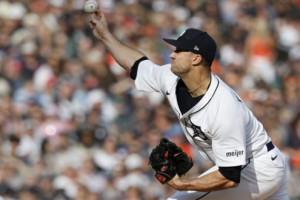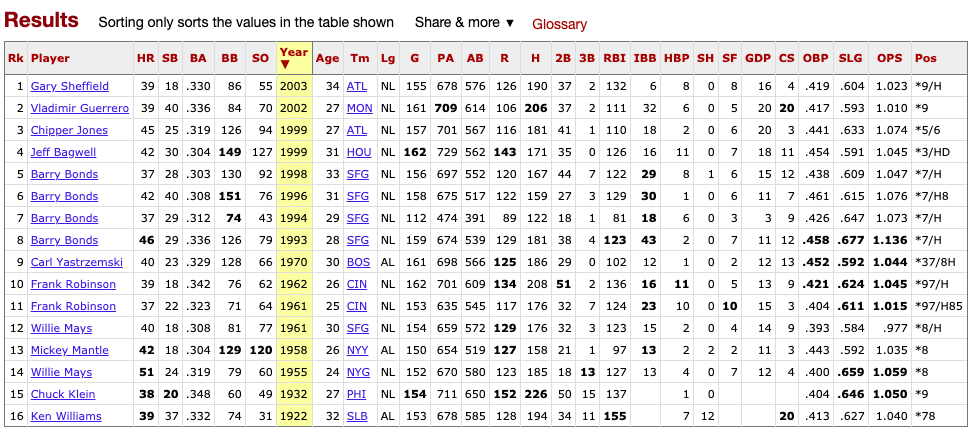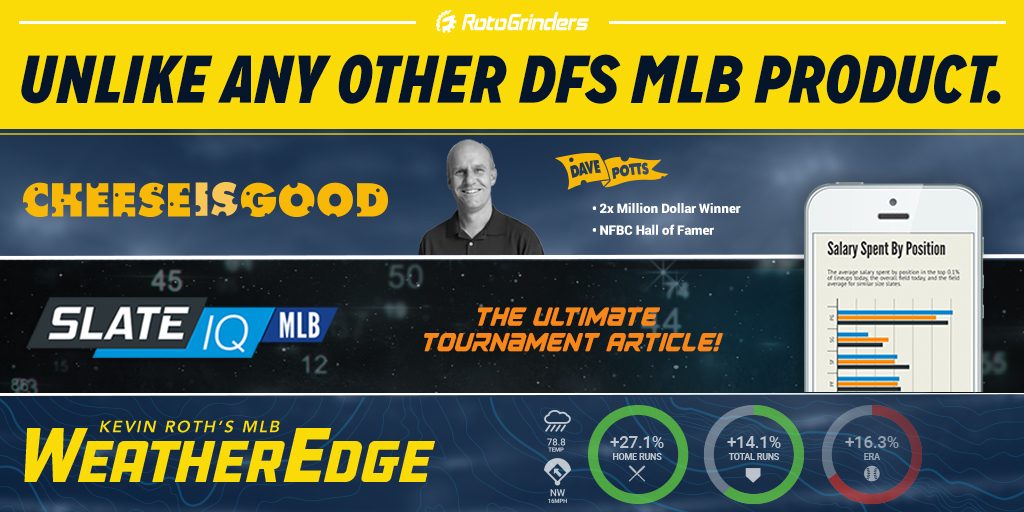10 Definitely Interesting, Possibly Helpful MLB Notes for Tuesday, June 18th
Welcome to 10 Definitely Interesting, Possibly Helpful Notes! In this column, I’ll work to uncover some interesting bits of information that might shed some light on players from that day’s slate of MLB games. This is not a picks column, nor is it a “fun facts” article – it’s something in between.
I hope you enjoy it, and I hope it helps you think about today’s MLB plays in a new way as you build your DFS lineups. Here are 10 Notes for Tuesday, June 18th.
1. Justin Verlander had a signature start his last time out, striking out 15 batters in a tough matchup with the Brewers. It wasn’t just the strikeouts that made the start so Verlander-esque, though; it was also the three homers he allowed, making it the first time in MLB history that a pitcher struck out 15 while allowing 3 long balls (and, if you care, there have only been 16 instances in MLB history when a pitcher has fanned 15 and allowed 2 home runs). Verlander has allowed 17 homers this year, tied for third-most in MLB, a fact that would be alarming if he didn’t have the ability to, you know, strike out 15 in any given start. But he can, and that’s why he’s a top play virtually any time he takes the mound. With a mid-tier bursting with viable options (Jack Flaherty, Brandon Woodruff, Yusei Kikuchi, Mitch Keller, to name a few), the only real question is whether we need to pay up for Verlander in a matchup against the Reds in homer-friendly Great American Small Ball Park.
2. Cole Hamels has allowed zero earned runs while posting a 29.1 percent K rate over his last three starts dating back to June 2nd. In his most recent start, Hamels tossed a seven-inning, nine-strikeout, no-earned-run gem at Coors Field, the first time all season a pitcher has posted that line at Coors. On Tuesday, he’s got a considerably easier matchup at home against the White Sox. It’ll be worth paying attention to the White Sox lineup, and if they try to counter the lefty Hamels with a bunch of right-handed batters, it’s no matter: Hamels possesses a devastating changeup that he throws primarily to righties, a pitch that has garnered a .122 average (lowest in MLB) and a .149 slugging (also lowest), and it’s partially why he’s got a 25.1 percent K rate against righties, compared to an 18.2 percent K rate against lefties. As a team, the White Sox fan at a slightly worse than league average 23.9 clip against lefties, and their 98 wRC+ is right around league average, as well. Hamels is a site-specific play on Tuesday, as he makes much more sense at FanDuel (where he’s $8,500 and the seventh-most-expensive pitcher) than at DraftKings (where he’s way up at $10,500 as the third-most-expensive pitcher).

3. Since 2018, only seven pitchers have a lower zone contact rate than Jack Flaherty, who has 81.5 percent: Chris Sale, Max Scherzer, Justin Verlander, Blake Snell, Gerrit Cole, Jacob deGrom, and Luis Castillo. In other words, from a “stuff” perspective, Flaherty is right there with MLB’s elite; he can generate swings and misses with the best of them. The results have been a bit shaky this season, with an ERA that is nearly a full run worse in 2019 (4.28) than 2018 (3.34). And if you’re saying, “But what about his SIERA?” (which, by the way, is something that is probably only ever said by readers of a DFS article), SIERA also agrees Flaherty has been worse this year (3.57 in 2018; 4.08 in 2019). Well, Mr. Flaherty, we’ve got just the remedy for you: The 2019 Miami Marlins, owners of a 24.8 percent strikeout rate against righties that ranks sixth-worst in MLB, not to mention a laughable .110 ISO against righties that is the worst by any team since the 2015 Braves. This is a clear “don’t overthink it” play: Flaherty at his suppressed price tag across the industry ($8,000 at FD; $8,700 at DK; $42 at Yahoo) is the top overall pitcher on Tuesday’s slate.
4. Against right-handed batters this year, Brandon Woodruff has a .240 wOBA and a 29.3 percent strikeout rate; that’s something only three other pitchers in MLB (min. 30 IP) can say (Paddack, Castillo, Maeda). This matters, given that virtually every one of the Padres’ best hitters – Machado, Renfroe, Tatis, Myers (and no, I’m not including Eric Hosmer among their “best hitters”) – are right-handed. Woodruff has been nothing short of a revelation for a Brewers staff that looked like a liability before the season started. And he’s amped it up even more as of late: Since May 26th, Woodruff is one of just six pitchers with multiple 10-strikeout games, joining Chris Sale, Gerrit Cole, Max Scherzer, Andrew Heaney, and Lucas Giolito. His shot of reaching 10 punchouts again isn’t as far-fetched as it might seem, as the Padres fan at an MLB-high 26.5 percent clip against righties. He still feels a bit underpriced at DraftKings in particular ($9,300). He’s a strong play in all formats.
5. Mitch Keller has been a highly touted prospect in the Pirates’ system for a few years, but his first two MLB starts couldn’t have gone much worse; in fact, he’s the first pitcher since Aaron Brooks in 2014 (and only the sixth since 1908) to start his career with two straight games of 6+ earned runs in 4 or fewer innings pitched. And yet, in a matchup with Keller, the Detroit Tigers have just a 3.88 implied run total, the fifth-lowest on the slate. That’s…incredible. To be fair, Keller should by all accounts develop into a good pitcher. And that’s why his bargain basement salary across the industry ($5,500 at FD; $6,900 at DK; $28 at Yahoo) is so appealing. There is strikeout upside with Keller, as evidenced by his 30.2 percent K rate at Triple-A this year, in addition to the fact that the Tigers strike out at an obscene 26.3 percent clip against righties, second-most in MLB. Given some of the excellent mid-tier options (and particularly Flaherty and Woodruff), there’s no reason to go this low in cash games. But if you’re looking to fit in an extra high-end bat or two in GPPs, Keller provides the route.
6. Over the past calendar year, Mike Trout has 36 home runs, 18 stolen bases, a .298 batting average, and more walks than strikeouts; that’s something that’s only been done 16 times over a full season in MLB history. Per Baseball Reference’s Play Index, here’s the full list, which is chock full of Hall of Famers and MLB legends:

We’re witnessing one of the greatest players of all time, and the great thing about DFS is that we can roster this guy every day. Occasionally, I decide against rostering Trout, and those night usually end in a smaller bankroll and/or a pool of my own tears. Tonight, he faces Marcus Stroman, who has been tough on righties in 2019 (.268 wOBA allowed). Even so, it’s not a night that you’re required to pay up for pitching, which means there should be plenty of salary to fit in Trout. Do it.
7. Three reasons to stack the Cubbies in a matchup against Ivan Nova:
— Just about the only feather in Ivan Nova’s cap is his ability to generate decent grounders. Well, Kyle Schwarber has a .266 ISO against ground ball pitchers since 2016; that’s eighth-best in MLB over that stretch (min. 200 PA).
— Ivan Nova throws primarily sinkers (41.5 percent this year); Willson Contreras has a .517 wOBA against sinkers since 2017, third-best in MLB (min. 100 BBE), trailing only J.D. Martinez (.586) and Whit Merrifield (.547).
— Anthony Rizzo has a .378+ wOBA and a strikeout rate of 17.2 percent or lower versus right-handed pitchers in all five seasons since 2015; no other hitter has even done that four times over that span.

8. Jose Ramirez’s HR/FB has plummeted by 13 percentage points this season; that’s the second-largest drop in MLB (Kendrys Morales; 13.1%). Ramirez has been one of the biggest disappointments of the season, but the sudden disappearance of his power has been, at least in large part, the result of plain old bad luck. Consider this: Ramirez’s average exit velocity on line drives and fly balls has barely dipped (92.4 mph in 2018; 91.7 mph in 2019), and the average distance on his line drives has actually slightly increased this year (289 feet in 2018; 290 feet in 2019). The elixir for Ramirez’s power decline may come in the form of a matchup with Adrian Sampson, who has allowed 1.79 HR/9 since 2018, including serving up four dingers to the Red Sox in his last outing. Ramirez is just too good of a hitter to be priced this low across the industry ($3,100 at FD; $3,900 at DK; $11 at Yahoo). With a 5.42 implied run total in the Texas heat, Cleveland should have no trouble putting runs on the board. Jose Ramirez is a cheap path to exposure to that offense.

9. Since 2017, only four batters in MLB have a .309+ batting average and better than 43 percent hard hits: Mike Trout, Christian Yelich, Freddie Freeman, and … David Peralta. Peralta has been one of the more underrated hitters in the game for the past couple years, especially when he’s got the platoon advantage (he’s batted .300 or better against RHPs in all but one season of a six-year career dating back to 2014). Not only does he have the platoon advantage on Tuesday, but he has the platoon advantage against a truly awful right-hander in Antonio Senzatela. Senzatela has allowed a hard-to-believe .433 wOBA to left-handed hitters this year, which ranks dead last among 92 qualified pitchers. Oh, and if you’re like me and still like to look at batting average occasionally (your author ducks for cover as a flurry of insults and hardback copies of Michael Lewis’s Moneyball are thrown at him), Senzatela has allowed an equally-hard-to-believe .353 average against lefties since 2017.
10. Robinson Cano has largely been a disappointment during his short stint with the Mets, but that’s mostly because of his sudden ineptitude against lefties (.157 wOBA, 35.7 K%…yikes). With the platoon advantage, he’s been pretty much fine (great sell for a DFS play, right? “Play this guy! He’s pretty much fine!”), with a .336 wOBA and a typically low 13.9 percent strikeout rate. If we go back just a couple years, we can see that Cano offers a really high ceiling due to his on-base skills against righties. He’s one of only six batters in MLB with a .360+ wOBA and a sub-13.0 percent strikeout rate against righties, joining Michael Brantley, Daniel Murphy, Justin Turner, Anthony Rizzo, and Jose Ramirez (all notably prototypical “cash game plays”). In a plus matchup against Braves righty Julio Teheran (who is still allowing plenty of hard hits to lefties at 40.0 percent), and at a crazy low salary across the industry ($2,700 at FD; $3,100 at DK; $7 at Yahoo), Cano represents one of the better point-per-dollar plays on the slate.
__________________________________________________________________________________________________________________________________
Thanks for reading! Stats from this article were pulled from RotoGrinders’ PlateIQ tool, FanGraphs, Baseball Prospectus, Baseball Savant, Brooks Baseball, and Baseball Reference.
Check back for more “10 Notes” MLB articles every Tuesday and Friday throughout the year, and feel free to leave a question or comment down below!
